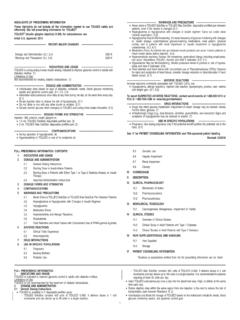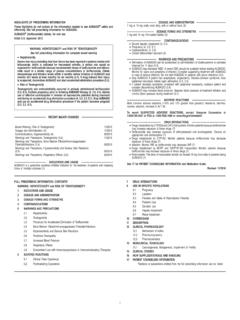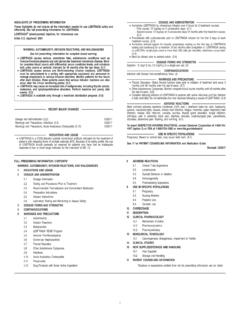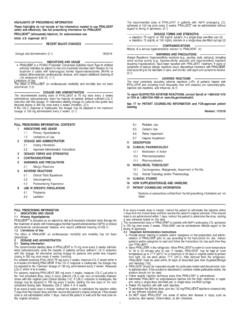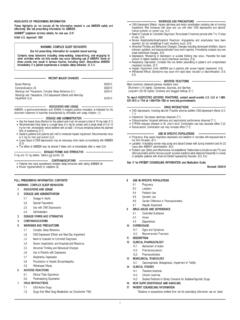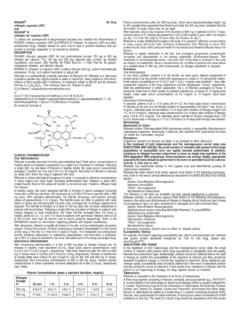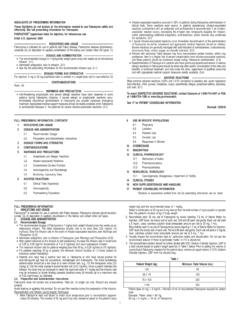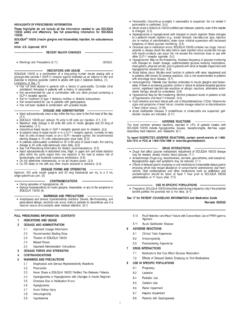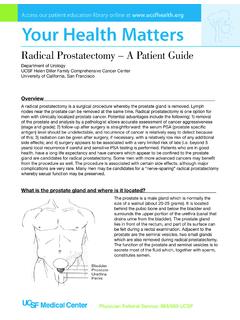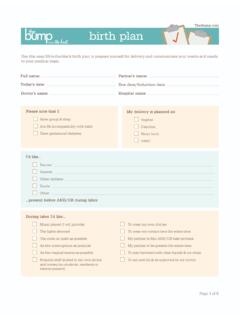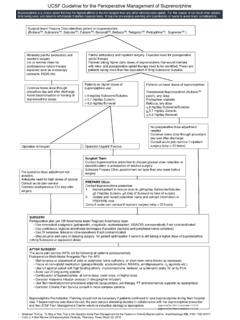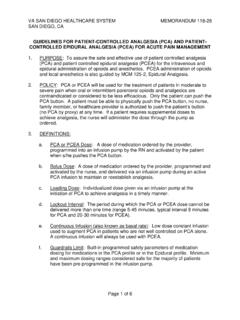Transcription of Single-dose prefilled syringes: 30 mg/0.3 mL, 40 ... - Sanofi
1 HIGHLIGHTS OF PRESCRIBING INFORMATIONT hese highlights do not include all the information needed to use LOVENOX safely andeffectively. See full prescribing information for (enoxaparin sodium) injection, for subcutaneous and intravenous useInitial Approval: 1993 WARNING: SPINAL/ epidural HEMATOMASSee full prescribing information for complete boxed or spinal hematomas may occur in patients who are anticoagulated with lowmolecular weight heparins (LMWH) or heparinoids and are receiving neuraxial anes-thesia or undergoing spinal puncture. These hematomas may result in long-term orpermanent paralysis. Consider these risks when scheduling patients for spinalprocedures. Factors that can increase the risk of developing epidural or spinalhematomas in these patients include: Use of indwelling epidural catheters Concomitant use of other drugs that affect hemostasis, such as non-steroidalanti-inflammatory drugs (NSAIDs), platelet inhibitors, and other anticoagulants A history of traumatic or repeated epidural or spinal punctures A history of spinal deformity or spinal surgery Optimal timing between the administration of Lovenox and neuraxial procedures isnot knownMonitor patients frequently for signs and symptoms of neurological impairment.
2 Ifneurological compromise is noted, urgent treatment is necessary. ( , 7) INDICATIONS AND USAGE Lovenox is a low molecular weight heparin (LMWH) indicated for: Prophylaxis of deep vein thrombosis (DVT) in abdominal surgery, hip replacement surgery,knee replacement surgery, or medical patients with severely restricted mobility during acuteillness ( ) Inpatient treatment of acute DVT with or without pulmonary embolism ( ) Outpatient treatment of acute DVT without pulmonary embolism ( ) Prophylaxis of ischemic complications of unstable angina and non Q-wave myocardialinfarction (MI) ( ) Treatment of acute ST-segment elevation myocardial infarction (STEMI) managed medicallyor with subsequent percutaneous coronary intervention (PCI) ( ) DOSAGE AND ADMINISTRATION See full prescribing information for dosing and administration information.
3 (2) DOSAGE FORMS AND STRENGTHS 100 mg/mL concentration (3): Single-dose prefilled syringes: 30 mL, 40 mL Single-dose graduated prefilled syringes: 60 mL, 80 mL, 100 mg/1 mL Multiple-dose vial: 300 mg/3 mL150 mg/mL concentration (3): Single-dose graduated prefilled syringes: 120 mL, 150 mg/1 mL CONTRAINDICATIONS Active major bleeding (4) History of heparin-induced thrombocytopenia (HIT) within the past 100 days or in the presenceof circulating antibodies (4) Hypersensitivity to enoxaparin sodium (4) Hypersensitivity to heparin or pork products (4) Hypersensitivity to benzyl alcohol (for multiple-dose formulation only) (4) WARNINGS AND PRECAUTIONS Increased Risk of Hemorrhage: Monitor for signs of bleeding. ( , , ) Risk of Heparin-Induced Thrombocytopenia with or without Thrombosis.
4 ( ) Thrombocytopenia: Monitor platelet count closely. ( ) Interchangeability with other heparins: Do not exchange with heparin or other LMWHs. ( ) Increased Risk of Thrombosis in Pregnant Women with Mechanical Prosthetic Heart Valves:Women and their fetuses may be at increased risk. Monitor more frequently and adjust dosageas needed. ( ) ADVERSE REACTIONS Most common adverse reactions (>1%) were bleeding, anemia, thrombocytopenia, elevation ofserum aminotransferase, diarrhea, nausea, ecchymosis, fever, edema, peripheral edema, dyspnea,confusion, and injection site pain. ( )To report SUSPECTED ADVERSE REACTIONS, contact Sanofi -aventis at 1-800-633-1610 orFDA at 1-800-FDA-1088 or DRUG INTERACTIONS Discontinue agents which may enhance hemorrhage risk prior to initiation of Lovenox or conductclose clinical and laboratory monitoring.
5 ( , 7) USE IN SPECIFIC POPULATIONS Severe Renal Impairment: Adjust dose for patients with creatinine clearance<30 mL/min. ( , ) Geriatric Patients: Monitor for increased risk of bleeding. ( ) Low-Weight Patients: Observe for signs of bleeding. ( )See 17 for PATIENT COUNSELING INFORMATION and FDA-approved patient labelingRevised: 12/2021 FULL PRESCRIBING INFORMATION: CONTENTS*WARNING: SPINAL/ epidural HEMATOMAS1 INDICATIONS AND of Deep Vein of Acute Deep Vein of Ischemic Complications of Unstable Angina and Non Q-WaveMyocardial of Acute ST-Segment Elevation Myocardial Infarction2 DOSAGE AND Reduction for Patients with Severe Renal Dosage for Geriatric Patients with Acute ST-Segment ElevationMyocardial for Safety3 DOSAGE FORMS AND STRENGTHS4 CONTRAINDICATIONS5 WARNINGS AND Risk of Risk of Bleeding following Percutaneous Coronary Risk of Bleeding in Patients with Concomitant Medical of Heparin-Induced Thrombocytopenia with or without with other Risk of Thrombosis in Pregnant Women with Mechanical Prosthetic of Serious Adverse Reactions in Infants due to Benzyl Alcohol Preservative6 ADVERSE Trials Experience7 DRUG INTERACTIONS8 USE IN
6 SPECIFIC with Mechanical Prosthetic Heart Patients10 OVERDOSAGE11 DESCRIPTION12 CLINICAL Mechanism of Pharmacokinetics13 NONCLINICAL Carcinogenesis, Mutagenesis, Impairment of Animal Toxicology and/or Reproductive and Developmental Toxicology14 CLINICAL Prophylaxis of Deep Vein Thrombosis following Abdominal Surgery in Patients atRisk for Thromboembolic Prophylaxis of Deep Vein Thrombosis following Hip or Knee Replacement Prophylaxis of Deep Vein Thrombosis in Medical Patients with Severely RestrictedMobility during Acute Treatment of Deep Vein Thrombosis with or without Pulmonary Prophylaxis of Ischemic Complications in Unstable Angina and Non Q-WaveMyocardial Treatment of Acute ST-Segment Elevation Myocardial Infarction16 HOW SUPPLIED/STORAGE AND HANDLING17 PATIENT COUNSELING INFORMATION*Sections or subsections omitted from the full prescribing information are not listedFULL PRESCRIBING INFORMATIONWARNING.
7 SPINAL/ epidural HEMATOMASE pidural or spinal hematomas may occur in patients who are anticoagulated with lowmolecular weight heparins (LMWH) or heparinoids and are receiving neuraxial anesthesiaor undergoing spinal puncture. These hematomas may result in long-term or permanentparalysis. Consider these risks when scheduling patients for spinal procedures. Factorsthat can increase the risk of developing epidural or spinal hematomas in these patientsinclude: Use of indwelling epidural catheters Concomitant use of other drugs that affect hemostasis, such as non-steroidal anti-inflammatory drugs (NSAIDs), platelet inhibitors, and other anticoagulants A history of traumatic or repeated epidural or spinal punctures A history of spinal deformity or spinal surgery Optimal timing between the administration of Lovenox and neuraxial procedures is notknownMonitor patients frequently for signs and symptoms of neurological impairment.
8 Ifneurological compromise is noted, urgent treatment is the benefits and risks before neuraxial intervention in patients anticoagulatedor to be anticoagulated for thromboprophylaxis[see Warnings and Precautions ( ) andDrug Interactions (7)].1 INDICATIONS AND Prophylaxis of Deep Vein ThrombosisLovenox is indicated for the prophylaxis of deep vein thrombosis (DVT), which may lead to pulmonaryembolism (PE): in patients undergoing abdominal surgery who are at risk for thromboembolic complications[seeClinical Studies ( )] in patients undergoing hip replacement surgery, during and following hospitalization in patients undergoing knee replacement surgery in medical patients who are at risk for thromboembolic complications due to severely restrictedmobility during acute Treatment of Acute Deep Vein ThrombosisLovenox is indicated for.
9 Theinpatient treatmentof acute deep vein thrombosiswith or without pulmonary embolism, whenadministered in conjunction with warfarin sodium theoutpatient treatmentof acute deep vein thrombosiswithout pulmonary embolism, whenadministered in conjunction with warfarin Prophylaxis of Ischemic Complications of Unstable Angina and Non Q-Wave MyocardialInfarctionLovenox is indicated for the prophylaxis of ischemic complications of unstable angina and non Q-wavemyocardial infarction, when concurrently administered with Treatment of Acute ST-Segment Elevation Myocardial InfarctionLovenox, when administered concurrently with aspirin, has been shown to reduce the rate of thecombined endpoint of recurrent myocardial infarction or death in patients with acute ST-segmentelevation myocardial infarction (STEMI) receiving thrombolysis and being managed medically or withpercutaneous coronary intervention (PCI).
10 2 DOSAGE AND Pretreatment EvaluationEvaluate all patients for a bleeding disorder before starting Lovenox treatment, unless treatment isurgently Adult DosageAbdominal SurgeryThe recommended dose of Lovenox is40 mgby subcutaneous injection once a day (with the initialdose given 2 hours prior to surgery) in patients undergoing abdominal surgery who are at risk forthromboembolic complications. The usual duration of administration is 7 to 10 days[see Clinical Studies( )].Hip or Knee Replacement SurgeryThe recommended dose of Lovenox is30 mg every 12 hoursadministered by subcutaneous injectionin patients undergoing hip or knee replacement surgery. Administer the initial dose 12 to 24 hours aftersurgery, provided that hemostasis has been established. The usual duration of administration is 7 to10 days[see Clinical Studies ( )].

